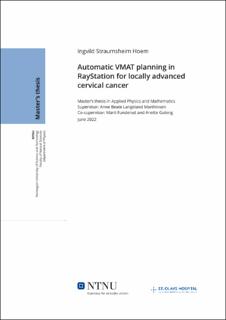| dc.contributor.advisor | Marthinsen, Anne Beate Langeland | |
| dc.contributor.advisor | Funderud, Marit | |
| dc.contributor.advisor | Guleng, Anette | |
| dc.contributor.author | Hoem, Ingvild Straumsheim | |
| dc.date.accessioned | 2022-10-13T17:20:50Z | |
| dc.date.available | 2022-10-13T17:20:50Z | |
| dc.date.issued | 2022 | |
| dc.identifier | no.ntnu:inspera:115378862:38090776 | |
| dc.identifier.uri | https://hdl.handle.net/11250/3026031 | |
| dc.description.abstract | Formål: Denne studien hadde som mål å utvikle et automatisk planleggingsskript for
volumetrisk modulert bueterapi (VMAT) av lokalavansert livmorhalskreft (LACC) for
bruk i RayStation, for å erstatte manuell VMAT-planlegging i klinikken. De automatiske
VMAT-planene skulle følge de nye retningslinjene for gynekologisk kreft publisert
av Helsedirektoratet i 2021 og bidra til redusert planleggingstid uten å påvirke
plankvaliteten negativt.
Materialer og metoder: Det automatiske planleggingsskriptet for VMAT ble designet til
å gi akkurat nok dose til målvolumene i følge de nye retningslinjene, og redusere dosen
til risikoorganer (OARs) så mye som mulig. Manuelle VMAT-planer fra 25 LACCpasienter
med og uten lymfeknutemetastase som har mottatt behandling ved St. Olavs
Hospital ble brukt som utgangspunkt for skriptoptimalisering og kvalitetsvurdering av
de automatiske VMAT-planene. De automatiske VMAT-planene ble kvantitativt sammenlignet
med de manuelle VMAT-planene ved hjelp av dosestatistikk fra RayStation
og VMAT-kvalitetssikringsmålinger (QA) med Delta4 fantomet. Planene ble kvalitativt
sammenlignet i en blindtest med 10 pasienter utført av fysikere og doseplanleggere
i klinikken.
Resultater: Det automatiske VMAT-planleggingsskriptet genererte en plan på 30-45
minutter. Fra dosestatistikken leverte de automatiske VMAT-planene høye nok, men
lavere doser til målvolumer enn de manuelle VMAT-planene. Dosen til de fleste OARs
var lik eller lavere med automatisk planlegging enn med manuell planlegging. De
automatiske VMAT-planene hadde en signifikant høyere konformitetsindeks enn de
manuelle VMAT-planene for alle målvolumer, hovedsakelig forårsaket av mindre doselekkasje
til friskt vev. QA-målingene viste at flere monitorenheter i de automatiske enn
de manuelle VMAT-planene ikke påvirket linacens planleveringskvalitet negativt. For
8/10 pasienter i blindtesten foretrakk minst 7/8 respondenter den automatiske fremfor
den manuelle VMAT-planen.
Konklusjon: Det automatiske planleggingsskriptet for VMAT utviklet for LACC-pasienter
reduserte planleggingstiden uten å redusere plankvaliteten. | |
| dc.description.abstract | Purpose: This study aimed to develop an automatic volumetric modulated arc therapy
(VMAT) planning script for use in RayStation to replace manual VMAT planning for
locally advanced cervical cancer (LACC) in the clinic. The automatic VMAT plans
should follow the new dose constraints for cervical cancer published by the Norwegian
Directory of Health in 2021 and contribute to reduced planning time without negative
effects on plan quality.
Materials and methods: The automatic VMAT planning script was designed to follow
the new dose constraints and to deliver just enough doses to target volumes and as low
doses as possible to organs at risk (OARs). Manual VMAT plans from 25 retrospective
LACC patients with and without lymph node metastasis treated at St. Olavs Hospital
in 2020-2021 were used for script optimisation and quality assessment of the automatic
VMAT plans. The automatic VMAT plans were quantitatively compared to the manual
VMAT plans by dose statistics from RayStation and VMAT quality assurance (QA)
measurements with the Delta4 phantom. The plans were qualitatively compared in a
blind test with 10 patients performed by physicists and dose planners in the clinic.
Results: The automatic VMAT planning script generated one plan in 30-45 minutes.
From the dose statistics, the automatic VMAT plans delivered high enough but lower
doses to target volumes than the manual VMAT plans. Doses to most OARs were
similar or lower with automatic than with manual VMAT planning. The automatic
VMAT plans had a significantly higher conformity index than the manual VMAT plans
for all target volumes, mainly caused by less dose leakage to healthy tissue. In the
QA measurements, the larger number of monitor units in the automatic VMAT plans
compared to the manual VMAT plans had no negative effect on the linac’s delivering
quality of the plans. For 8/10 patients in the blind test, at least 7/8 respondents
preferred the automatic VMAT plan over the manual VMAT plan.
Conclusion: The automatic VMAT planning script developed for LACC patients did
reduce planning time without reducing plan quality. | |
| dc.language | eng | |
| dc.publisher | NTNU | |
| dc.title | Automatic VMAT planning in RayStation for locally advanced cervical cancer | |
| dc.type | Master thesis | |
